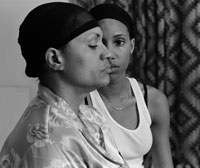With LaToya Ruby Frazier’s solo exhibition The Notion of Family, Hagedorn Foundation Gallery introduces a major new talent to Atlanta. The show includes a dozen moderately sized black-and-white photographs and a single video for a riveting and ultimately satisfying experience.
The Notion of Family documents the photographer’s family life over the span of seven years. Frazier was raised by her grandparents near Pittsburgh, Penn., while her mother battled drug addiction and a long stint in prison. Frazier’s relationship with her mother, fraught with alienation and mutual suspicion, forms The Notion of Family‘s emotional core. The two women collaborated on many of the photos, mother and daughter taking turns directing shots and composing images.
The result is a fractured yet deeply affecting series of glimpses into a complex web of relationships encircling grandparents, boyfriends and other characters. The shots seem casual: a grandmother lighting up a cigarette among an eerie collection of porcelain dolls in “Grandma Ruby Smoking Pall Malls.” A woman, whose body is visible only from the waist down, sitting on a bed beside a shirtless man engrossed in what must be a television set somewhere off camera in “Mom and Her Boyfriend Mr. Art.” The images are silent testaments to a family struggling for normalcy, yet always pregnant with unease and unspoken anxieties.
This tension is perhaps most clear in the masterfully dramatic “Me and Mom’s Boyfriend Mr. Art.” A thick black threshold bisects the picture vertically down the middle. To the left, an older man sits on a bed and leans nonchalantly on one elbow, his back to the camera. To the right, we have a partial view into another bedroom, this one with a young woman sitting upright against the wall. She wears a worried expression on her face and holds a glinting blade delicately on one thigh. The blade might be a knife or it might be a letter opener, but either way it’s sharp and menacing.
Missing from the picture is the mother. Yet she’s everywhere in the photo – the link in the implied strained relationship between the man and the girl. What familial violence is poised to happen? What worrisome interactions have just been witnessed? “Me and Mom’s Boyfriend Mr. Art” is a striking invitation to such questions carried off without a whiff of contrivance.
Frazier’s portraits are equally penetrating. None show any evidence of elaborate staging or prettying up for the camera. Indeed, the photos’ subjects give off the distinct impression of being willfully unpretty. Hair is left a mess, clothes are disheveled, the emotional curtain is pulled back. In “Mom” the title figure stares coldly and unblinkingly at the camera. The light is hard and largely unflattering. It’s as if the subject wants to be caught in the brightest possible glare and expose everything hidden to a cleansing light.
In some ways, Frazier’s territory is a familiar one: We’ve seen off the cuff, intimate portraits of family and other familiars in their natural surroundings before. Think Sally Mann’s skinnydipping children or Atlanta photographer Angela West’s father lurking in the Georgia woods. In such photos, the boundary between documenter and documented is a clear and fixed line. The photographer holds the camera, while her subject performs knowingly or unknowingly in a dance the artist choreographs.
The Notion of Family blurs that line as Frazier inserts herself into many of the shots. Her lens is aimed as critically and unpityingly on herself as on any of her other subjects. With this body of work – still early in her career – Frazier exhibits a fearlessness.
While Frazier’s The Notion of Family occupies Hagedorn’s upper gallery, Documents: City Lifeoccupies the lower. Documents comprises five photographers who turn their lenses toward everyday people in everyday sorts of places. The photographers’ shared ability to give average moments a resonant immediacy connects all of the portraits (the work here is almost all portraiture). It’s a tradition that spans art history from these photographers back to documentary photographer Gordon Parks and French painter Edouard Manet.
In Malick Sidibé’s chronicling of Malian nightlife and its hipster characters of the ’60s and ’70s, the subjects often strike poses as though they’re aware of their own status as historical documents. The Sidibé prints chosen for Documents are uniformly brilliant, but they’re also his classics and as such are surefire hits.
Riskier are Dawoud Bey’s large black-and-white portraits of everyday young people in Brooklyn and Washington, D.C. A couple enfolded in one another’s arms. An albino boy by a window sill. Bey’s subjects reward the risk.
Paul D’Amato’s large color prints are Documents’ unexpected gems. Channeling the history of painting from Caravaggio to Vermeer, D’Amato shows that historical reference need not feel oppressive or forced. Historical images by Wayne Miller and a series of Peter Bahouth’s stereoscopic images round out the downstairs exhibit.
Both exhibitions are affiliated with the National Black Arts Festival, the annual summer multi-arts fest whose visual arts offerings this year hit and miss in equal measure. Curating a show around an identity element inevitably risks ghettoizing its artists and oversimplifying its subject matter. But Hagedorn nimbly sidesteps this trap by chronicling timeless themes of relationships and the people with whom we share our space.

